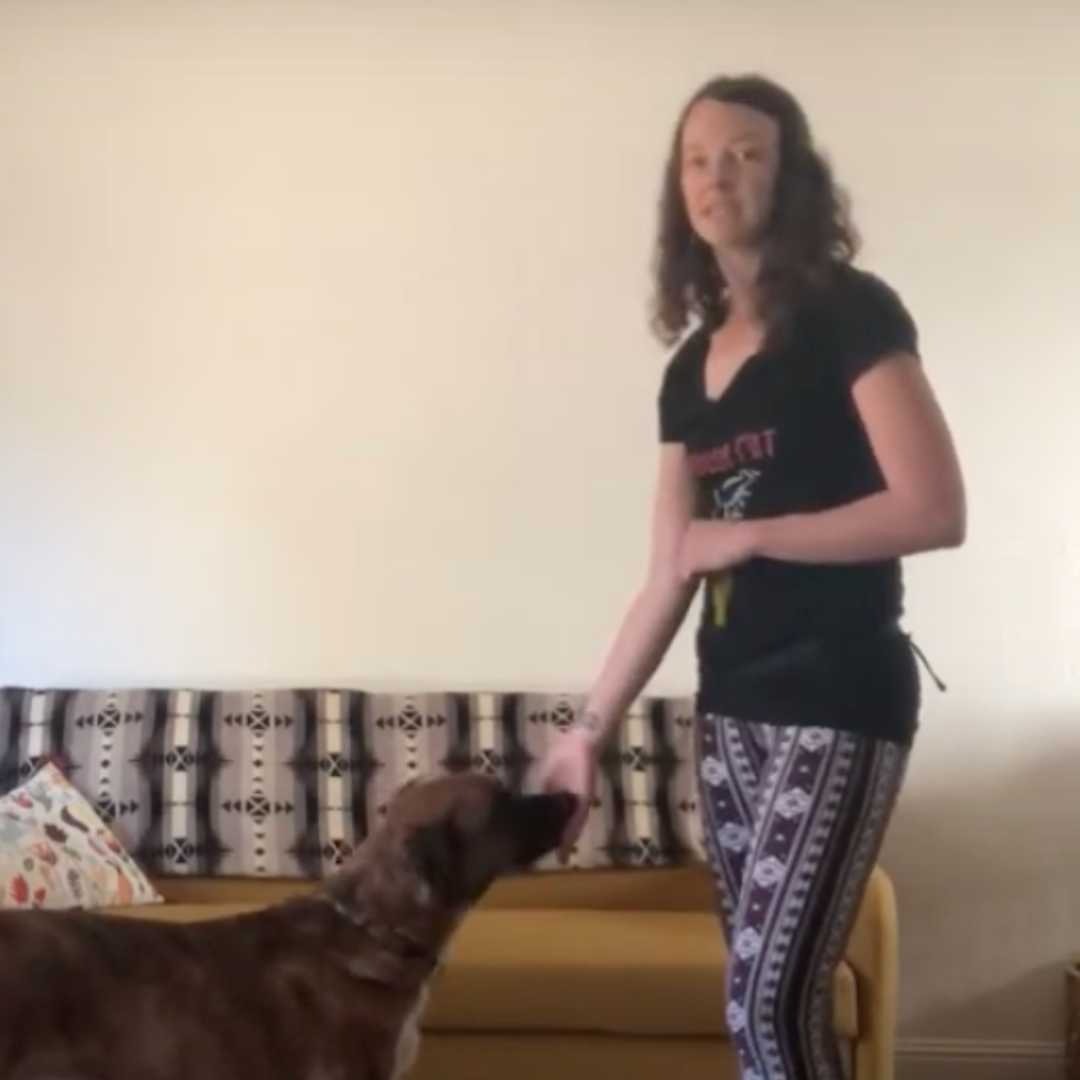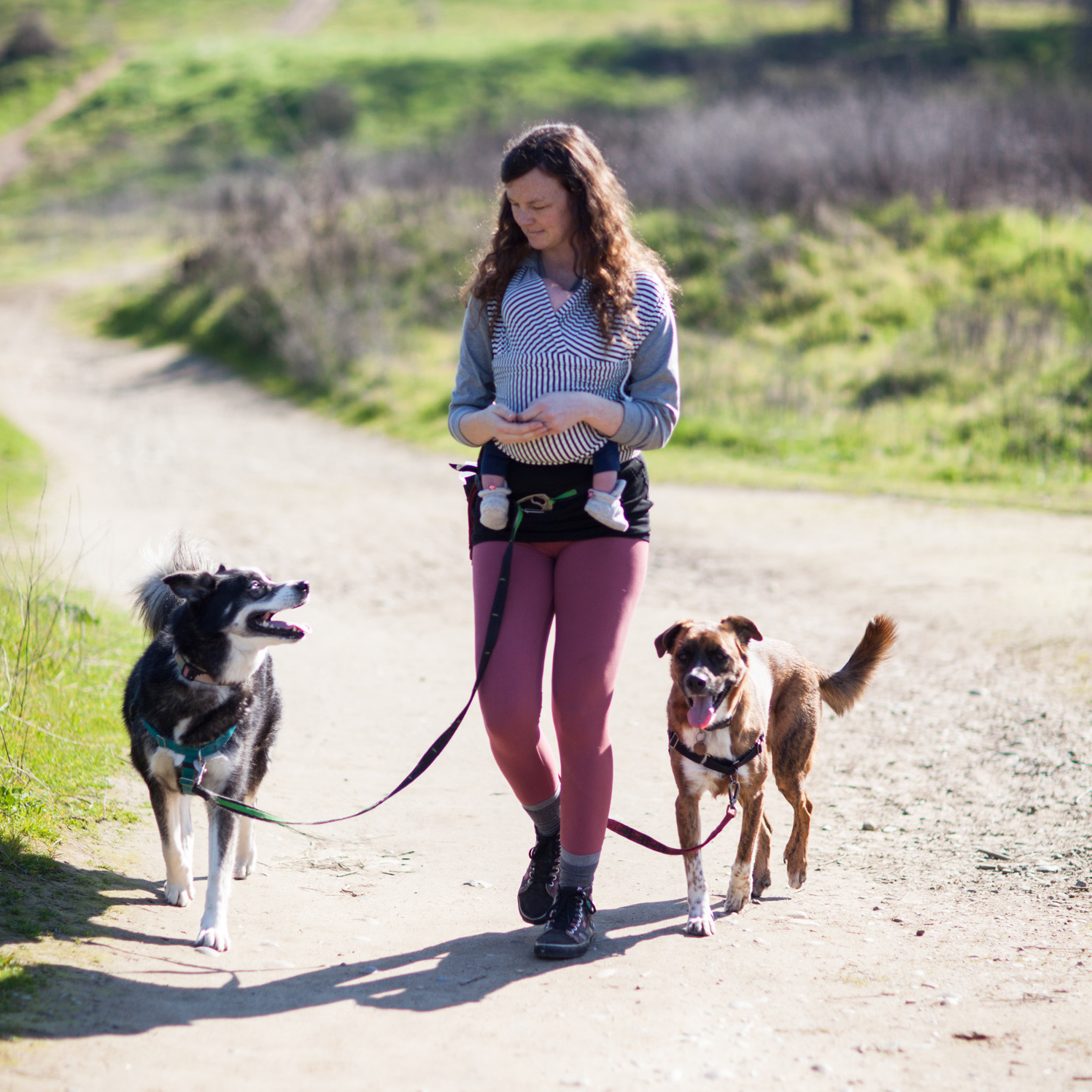If you want your stay command to be practical in everyday situations, you're going to want to be able to break eye contact from your dog and turn away while your dog remains in the stay position, whether that's in a sit, stand, or down.
Teaching your dog to stay when turning your back can help keep your dog safe if you're not able to give them your full attention. Remember, there should be no distractions for your dog at this point in training!
Why does this matter
Many dogs know how to stay while their owner takes small steps backwards, keeping eye contact, and repeating the stay word over and over again. But is that realistic in your life? Are you always going to be able to keep direct eye contact with your dog while wanting them to hold the stay position in sit? Probably not. You're going to want to be able to turn away. You're even going to want to walk away and create some distance between you and your dog while your dog remains in stay but we'll talk about adding distance in the next guide.
Here's how to teach a dog to stay when turning your back in small, easy steps for your training sessions using positive reinforcement.
Your Dog's Plan
Stop! Don't read this long article. Instead, get everything you need to know, including all advice on Stay, in a customizable step-by-step plan for your dog created by our community of certified trainers and nutritionists.
Step 1: Ask your dog to stay, then break eye contact
For some dogs the best way to begin is by simply giving your dog a verbal cue by asking your dog to stay whether that's in a sitting position or down position and removing your gaze from your dog. Turning your head, for example. Does your dog move? If not, your dog may find that easy, in which case you can skip to the next step. Many dogs are so used to having your eye contact they need more time to be successful at this and hold the stay. Either way, get your treats ready to keep your dog motivated! And remember, it's always better to gradually increase the difficulty when teaching your dog a new behavior so your dog doesn't get frustrated.
Try this
Give your dog the stay cue. Break eye contact by turning your head away for a few seconds. Click and treat as a reward before your dog moves. Repeat. Break eye contact for a few more seconds each time. Always giving treats as rewards to your dog before he/she moves for giving you the behavior you want.
Step 2: Ask your dog to stay and turn away slightly
The next step as you teach your dog to stay for use in realistic situations is teaching your dog to stay while you turn your body away slightly. Every dog is different, so just touching one foot behind you and shifting your weight away from your dog for a second could be a good starting point. Or your dog could be ready for you to fully pivot your foot and shift your weight while looking away. It all depends on your dog's comfort level.
Pro tip, to get a better performance from your dog, always remember to go at their speed! Reward your dog with lots of treats before your pup moves to make it easier to understand this new behavior and feel success immediately.
Tell me more
First start your practice session by lightly putting one foot behind you and shifting your weight and gaze away from your dog. Click, come back to your dog, and treat. If your pup holds his/her stay and is comfortable with that, you can graduate to the next level of training by fully shifting your weight to that back leg while you look away. Click, come back to your dog before he/she moves, and treat. After a few repetitions and if your dog is comfortable holding stay, you can continue your practice by shifting your full weight to your back leg and bringing your other leg with it so you're now fully turned away from your dog. Click, come back to face your dog, and treat.
Training your dog to hold the stay command without moving while you're turned away is the ultimate goal of this new behavior. We'll talk more about how to practice this behavior with your back fully turned away from your dog below.
Try this
Cue your stay with your dog sitting or standing. Shift your weight so your body turns away slightly from your dog. Click, return to your original position, and treat to reward your dog for not moving. Repeat while gradually increasing the amount of time your body is turned away from your dog as your dog is comfortable holding stay. Click and treat every time always giving rewards to your dog.
Stay
Interested in Stay? Follow topics you're interested in to customize your dog’s step-by-step plan so it's most helpful and tailored to your dog when you're ready to get started.
Step 3: Ask your dog to stay and turn your back
After your dog has mastered the above steps, you're ready to teach your dog the stay cue with a back turn. This is the whole point of this training, so yay! You made it! Training your dog to stay while you turn your back and eventually start to walk away (we'll get to distance next!) is incredibly useful for real life and is a great cue for you and your dog to know.
Tell me more
In a training session, have your dog sit or stand in front of you. Give the verbal cue of "stay" and turn fully away from your dog. Count to three or five seconds, click, return to facing your dog, and treat while he/she is still sitting or standing. If your dog moves while your back is turned, return to working on training the previous steps. Remember, there's no shame in taking more time to learn a new behavior! The more we practice with our dogs, the more we set them up for success in the future.
Try this
Cue your dog's stay and step backwards to turn your back. Hold for a few seconds. Click, return to face your dog, and treat. Repeat while gradually increasing the amount of time your body is turned away from your dog as long as your dog is comfortable holding stay. Click and treat every time to reward your pup.
Step 4: Build in duration and turning both ways from your dog
Once your dog is comfortable in a stay with your back turned whether you've asked your dog to sit or stand, you can start building in more duration. Continue the above exercises, gradually increasing the time you turn away from your dog. Can your dog hold a stay while you stand with your back turned for 30 seconds as an example? Or even a few minutes?
Remember, just because we are adding duration doesn't mean your dog is ready for you to walk away yet or add in any distractions. Training is a gradual build where consistency is key. Going too fast for your dog or adding in too many new elements will confuse their training which we never want to do!
Tell me more
You can also try turning away from your dog in the opposite direction. Were you always turning right before to have your back to your dog? Try going left to make sure your dog is still comfortable. We want to teach our dogs to be comfortable in a stay as we turn our back in any direction, whether that's turning to the right or left.
Try this
Cue your dog to stay, turn to the right so your back is to your dog, hold for a short amount of time. Click, return to face your dog, and treat while still in stay. Turn to the left with your back to your dog, hold for a short amount of time. Click, return to face your dog, and treat while still in stay. Repeat extending the duration of time your back is turned while alternating sides and ensuring your dog is always comfortable and well rewarded.
Manners
Need more advice? Browse all guides in the Manners Channel on topics like Go To Mat, Food Manners, Party Manners, Stay, Public Manners, Travel Manners, and Basic Manners - created by our community of certified experts for you and your dog.
Step 5: Release your dog and have fun
Standing or sitting still for long periods of time isn't fun for anyone! Give your dog the release cue and let your pup be silly and get the wiggles out. And of course, feel free to join in! Training should always be fun so remember it only takes practicing 15 minutes per day and should be rewarding for both of you!
Learn how to teach your dog to stay when you're not looking, ensuring your dog's safety and good behavior.
Choose how you'd like to view this guide's video.

Next up in the Manners Channel on Dogly
Now that your dog can "stay" for long periods of time with your back turned, you're ready to start adding distance to your "stay" cue. Continue to part three of teaching your dog to "stay" in the next guide here to learn how to add distance.
And as always, if you ever have questions feel free to ask them in the Community discussion or I'm happy to help you 1-1 if you would like more personal training guidance.

